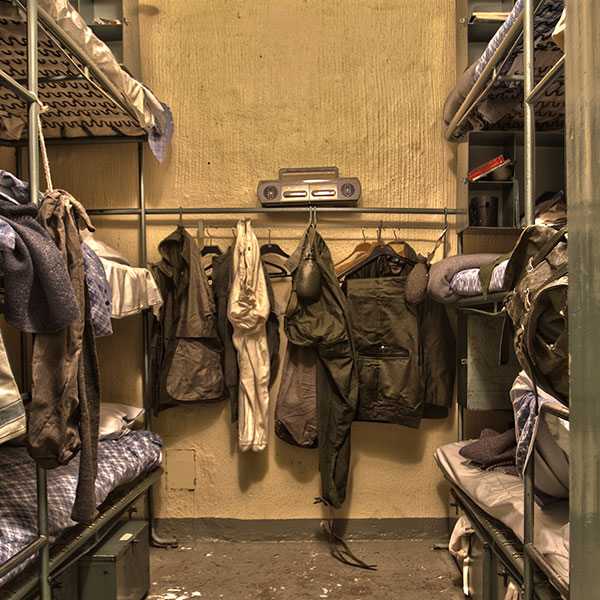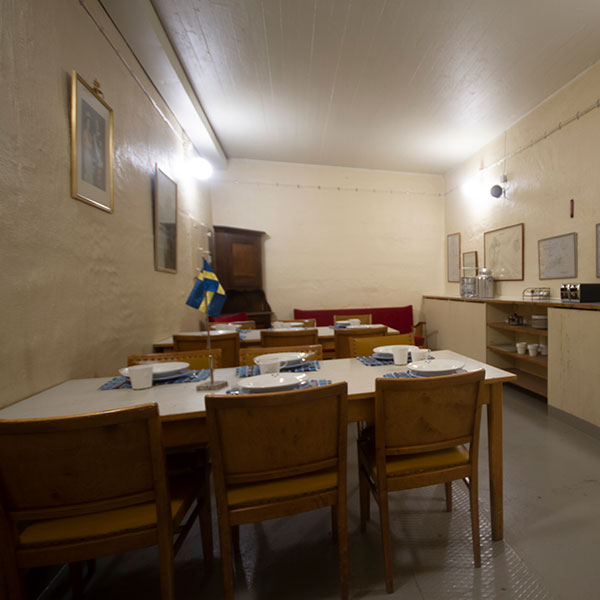Storåberget (HÖ1)
40 meters down into the bedrock
According to the 1942 defense decision, Hemsö Fortress was to be developed into Sweden’s largest fortress ever. The decision also involved strengthening the coastal artillery at the northern ports and adding several mine lines in the waters at the mouth of the Ångerman River.
The threat during the Cold War also led to a significant expansion of the defense along the Norrland coast with modern facilities in the mountains, which began in the early 1950s. The battery at Storråberget was constructed between 1953-1957.
The fortress was built with a complete supply system to accommodate 340 people during wartime. However, in peacetime, the strength was reduced to 200 conscripts who received their training in the battery. During peacetime, the battery was manned by officers and conscripts from the coastal artillery regiment KA 5 in Härnösand.
The facility is located forty meters excavated into the bedrock and consists of hundreds of meters of long corridors and a total area of approximately 5000 square meters. Artillery pieces, radar stations, and anti-aircraft positions above ground are accessed from the chambers via stairs, locks, and tunnel systems.
The mountain and concrete covering are impervious to artillery projectiles and aerial bombs and protect against blast waves, initial radiation, and residual radiation from nuclear charges. The chamber was excavated from the 140-meter-high Storråberget and was designated as atomic bomb-proof. It would withstand a detonation of 20 kilotons directly above the fortress. If a nuclear charge of the same size as the one dropped on Hiroshima hit the facility, it was estimated that two-thirds of the facility would still be combat-ready.
The fortress housed accommodation for all serving personnel, as well as kitchens, dishwashing rooms, food stores, and dining areas. Two mess halls and a canteen were also available. A diesel-powered generator provided the fort with electricity, and a deep-drilled well provided fresh water. The facility was designed to be isolated from the outside world for about three months, with the necessities stored in the chambers.
In 1998, the government decided that Hemsö Fortress would be a state-designated historical monument. That same year, the battery in Havstoudd was opened for public tours. The battery in Storråberget was sporadically opened for tours in 2005.
In 2000, the Swedish National Property Board took over the management of the fortress. Since the fall of 2009, Christer and Kristina Sefbom have been managing Hemsö Fortress, including all three facilities, Storråberget, Havstoudd, and Kläffsön.
Warning: Trying to access array offset on value of type bool in /data/7/0/70ffe675-feac-41d4-b2c4-4da3213114e6/hemsofastning.se/sub/en/wp-content/plugins/elementor/includes/base/widget-base.php on line 224
Warning: Undefined array key -1 in /data/7/0/70ffe675-feac-41d4-b2c4-4da3213114e6/hemsofastning.se/sub/en/wp-content/plugins/elementor/includes/base/controls-stack.php on line 696



The command corridor
The heart of the facility
Support facilities
Kitchen, infirmary, machinery hall, equipment storageLodgings
Where the soldiers slept



Mess halls
There are 3 mess halls in the mountain
